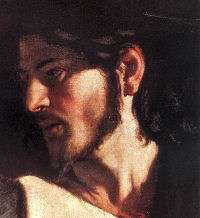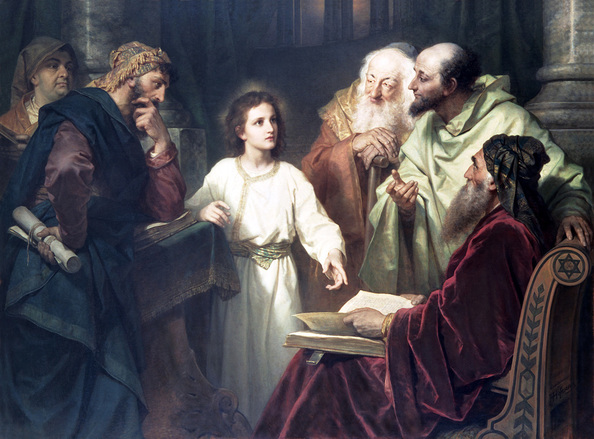The Call of Matthew According to Caravaggio

Caravaggio’s “Call of Matthew” is a meditatio on the lectio of today’s Gospel. It gives rise to oratio and leads to contemplatio. I am amazed at Caravaggio’s ability to depict in shadow and in light the struggle of the soul to escape the darkness of sin and the mysterious inbreaking of divine light. The artist’s own struggles with the great human passions — and with sin — made him, in his own way, an evangelist of the mercy of God.
September 21
Saint Matthew, Apostle and Evangelist
The Inbreaking Light
On this feast of Saint Matthew, it is the Apostle and Evangelist himself who relates what happened the day Jesus passed by, saw him, and called him, saying, “Follow me” (Mt 9:9). I have been looking at Caravaggio’s famous painting of the call of Saint Matthew. Caravaggio places the event inside a dark house. The only light comes from an open window just above the head of Christ; it illuminates the face of Matthew seated at his counting table. Matthew has the somewhat jaded fleshy face of a prosperous banker. He is well dressed and is wearing a kind of velvet cap.
The Three Stages of Life
To Matthew’s right a young boy is seated; he too is fashionably dressed, sporting a white plume in his cap. (He looks like a younger version of Matthew.) To Matthew’s left there is an old bespectacled man bent over the table and totally absorbed in counting his coins. Caravaggio is showing the three stages of life: youth, middle age, and old age. Matthew is seated between youth and old age. The youth depicts what Matthew once was: open, innocent, not yet crooked and corrupted. The old man counting his money depicts what Matthew risks becoming: a man in love with one thing only, his money.
The Luminous Face of Jesus
The Face of Jesus is in the light while all around Him there are shadows. In His eyes we see a divine intensity and the most poignant tenderness. Christ is extending his hand and pointing at Matthew. Matthew, clearly shocked and not quite believing what is happening to him, points to himself as if to say, “Me? Are you addressing me?” Caravaggio’s painting is, in its own way, a marvelous homily on today’s Gospel.
Your Story and Mine
The call of Matthew, as recounted in his Gospel and as portrayed in Caravaggio’s painting, is more than the story of one man’s experience of Jesus Christ over two thousand years ago. It is your story and mine. It concerns each one of us just as much as it concerns Saint Matthew, for the Lord Jesus says: “Those who are well have no need of a physician, but those who are sick. . . . For I came not to call the righteous, but sinners” (Mt 9:12-13).
The Divine Physician
If you are sick in any way, if you are afflicted, burdened, wounded, broken, twisted, ailing or weak, then you have reason to rejoice. Christ the Divine Physician comes for you! For you was His Heart opened flowing with water and blood: water to cleanse you of sin, and blood that you may have new life, “and have it more abundantly” (Jn 10:10).
Balm, Food, and Drink
The Divine Physician comes to anoint you with His Holy Ghost. The Holy Ghost is the healing balm of the Father and the Son spread over the wounds of the soul. And then, He nourishes you at the Holy Table of his Body and Blood. The Divine Physician would have you grow strong with the very strength of God, a strength that needs your weakness if it is to shine forth. “My grace is sufficient for you, for my power is made perfect in weakness” (2 Cor 12:9). The strength of Christ is displayed and illustrated in the weakness of those whom He calls.
The Past No Obstacle
Our Lord calls each of us today, just as he called Matthew out of that dark and dreary counting house to leave all and follow him into the light of day. The number of our years and the burden of our infirmities, are no obstacle. Our past, with its mistakes, failures, and sins, is no obstacle.
And He Rose
When Christ calls, the Holy Ghost urges us from within to rise up and follow him. It is a pity that the American lectionary uses the weak, “and he got up,” instead of the splendidly significant, “and he rose” of the Revised Standard Version. (The Greek verb is the very one used to denote the resurrection of Christ.) Caravaggio shows Matthew just before his spiritual resurrection. He is still seated; he is in that moment of decision where disbelief wrestles with hope. In Matthew’s case, hopes wins. There is a spiritual resurrection. Matthew rises and follows the Master with the luminous face.
Rescued by the Sacraments
We too rise to newness of life at the call of Christ, and follow Him not by running after Him with our feet, but by running after Him with desire of our heart. We come Him in the Sacrament of Penance; we come to Him in the Most Holy Eucharist; and in both sacraments we experience the mercy that rescues us from what we are in danger of becoming: empty shells clinging to pathetic little attachments, and incapable of seeing beyond them.
Equipped for Apostleship
What happens once we have experienced the call of Christ? We become apostles. We want to share with others what it is to see that Face and to be called by that Voice. To help us live out our apostleship, Our Lord equips us with the Seven Gifts of the Holy Ghost and with a variety of other graces. This is what Saint Paul said in the First Reading: “And his gifts were that some should be apostles, some prophets, some evangelists, some pastors and teachers” (Eph 4:11).
A Variety of Gifts
Some of you have the precious gift of spending long moments before Our Lord in the Blessed Sacrament. Others of you have the gift of bearing patiently with your infirmities. Others have the gift of a smile and a kind word. Still others have the gift of looking out for others, of being attentive and generous. All of these gifts build up the Body of Christ, the Church. God is a lavish giver! He wants to enrich us “with every spiritual blessing” (Eph 1:3). No one goes way from the Table of Divine Mercy without a gift.
The Newness of His Mercies
Be attentive today to the voice of the Merciful Christ and to the light that shines from His Holy Face. Study Caravaggio’s painting of the Calling of Saint Matthew. Even if you first heard the voice of Christ forty or fifty or sixty years ago, today He calls you anew. His mercy is not given once and for all; Scripture says: “The steadfast love of the Lord never ceases, His mercies never come to an end; they are new every morning” (Lam 3:22-23). The mercies of the Lord are ours in the adorable mysteries of his Sacred Body and Precious Blood. We, publicans and sinners, are welcomed at His Holy Table today. Blessed are those called to the Supper of the Lamb.


“If today you hear His voice, harden not your hearts”
I love that painting and that Gospel!
Matthew chose Life and lived to tell about it (about Him).
Gratefully,
Agnieszka